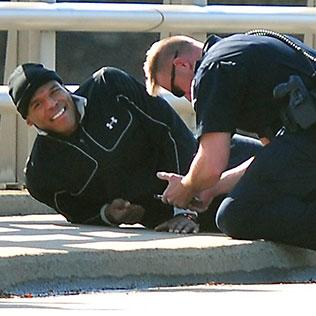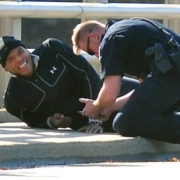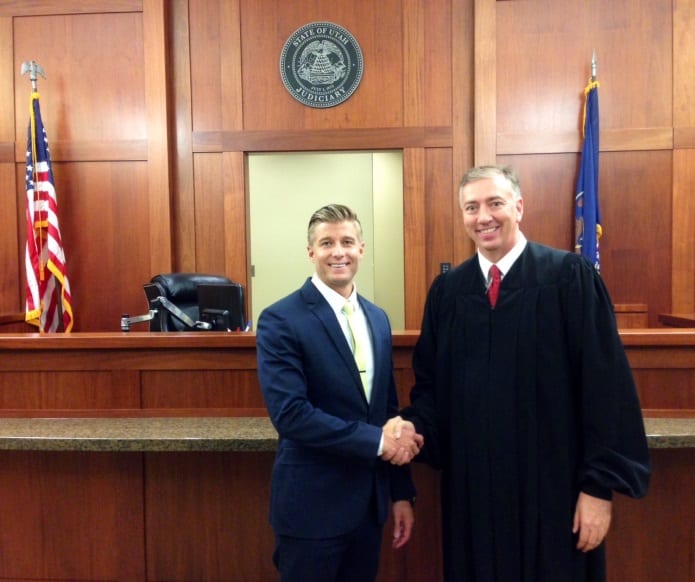
Reports indicate that Cam Newton, of the NFL’s Carolina Panthers, was involved in an automobile accident on Tuesday morning, December 9, 2014. Obviously, the most important news that could break related to this accident is that Mr. Newton is perfectly fine and that his recovery will be swift. I wish him the best. However, this article is written for a different purpose. It is my intent to use this example to educate readers about Tort Law in the State of Utah and to help explain why it is that injured victims recover money after car accidents. This accident provides an opportunity to explain complex legal theories in a way that is very easy to understand.
At this time, it is unclear who was at fault for this accident. For purposes of this article, we are going to pretend that the other driver, not Mr. Newton, was at fault for this accident. We will also pretend that this accident occurred in the State of Utah and we will therefore apply Utah Auto Law.
When one person harms another, in addition to sometimes being a crime, it is often a “tort” or civil wrong. It seems obvious that we should be made whole when someone hurts us on purpose, but what about by accident? Are all accidental injuries compensable? No. In order to recover when someone else hurts you by accident, you must be able to prove a case for negligence. A valid claim for negligence consists of four elements: duty, breach, cause, and harm.
In which arena of our modern society do people most commonly hurt one another by accident? The answer is obvious. People get hurt when we drive metal boxes around in close proximity to one another at high rates of speed. That is why some people associate lawyers with car accidents. Car accident victims often need attorneys to make their negligence case against the at-fault driver’s insurance company so that they can get a fair recovery for their injuries.
We all have a duty to obey the traffic laws and to drive reasonably according to the current traffic and weather conditions. When we breach that duty and the result is an accident, we will be found at fault for the crash. Proving who was at fault can be a difficult task, but often times, proving causation and damages can be even more complex. Insurance companies are very good at pointing the finger at other potential causes for a given injury. If they can show that the injury was preexisting, or that it was not directly and proximately caused by that exact car crash, they can get off the hook. Proving damages is an art, not a science; this is where the Cam Newton example comes in handy.
Currently, the most recent reports are stating that Mr. Newton suffered “two transverse process fractures in his lower back.” Let’s assume that those are his only injuries. Mr. Newton would be entitled to recover from the at-fault driver (or more likely, their insurance company), for all special damages and general damages caused by that crash. Special damages are things that have an exact bill. Mr. Newton was transported by ambulance to the hospital bill. Even if released immediately, he would have incurred bills from the ambulance company, the radiology company, and the emergency room. More likely than not, those injuries will require some form of follow up care from a variety of medical professionals. Healthcare is extremely costly, especially if surgery is required. In order to be made whole, Mr. Newton must recover the amount of all of his bills.
In addition to his medical bills, his lost wages must be included in special damages. Let’s pretend that Mr. Newton is unable to play this Sunday. What if his contract precludes him from being paid his salary when he suffers from a non-football injury? How much money would Mr. Newton be losing? Answer: an awful lot.
But, even if he is paid for all of those special damages, it’s still not an even trade right? He is not made whole because he is not put back in the place he was in just prior to the accident. After all, no one would say, “Hey, you can go ahead and hit me with your car so long as you agree to pay my doctors for the necessary treatment they provide me.” That would be insane. Mr. Newton would need to be paid for his general damages in order to be made whole under the law.
With Cam Newton, the potential general damages are enormous. General damages are those that affect each person differently. The pain and suffering, and loss of enjoyment of life that Mr. Newton could experience are enormous. Let’s pretend again that Mr. Newton’s injuries keep him sidelined for this Sunday’s game. Although the Panthers have had a weak season, their playoff hopes are still alive because their entire division has struggled. If Mr. Newton were to play the rest of the season, and the Panthers were to win out and make the playoffs, perhaps they would go on to win a Super Bowl. How much is winning a Super Bowl worth to a person? If you asked Dan Marino how much he would pay to go back in time and win a Super Bowl, how much would he say? Odds are, the value is enormous- probably millions. Obviously, there are some serious causation issues here because it is unlikely that the Panthers would win a Super Bowl this season even with a healthy Cam Newton, but you get the idea.
So, if you can recover money for something as “trivial” as emotional trauma, then how much would each Panther fan be entitled to after watching their Newton-less Panthers be defeated by the lowly Buccaneers this Sunday? Answer: Although that does sound painful, they get nothing. With limited exceptions, the rule is that one must suffer physical injury in order to recover for his or her emotional injuries.
So what is the lesson? Drive carefully. Do not run into anyone, and especially do not run into Cam Newton.
By: S. Andrew Spainhower, Esq.
Photo Credit: The Charlotte Observer






